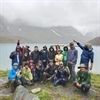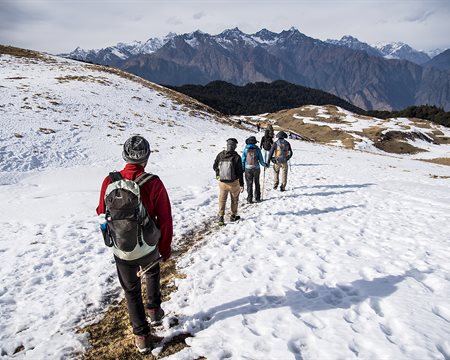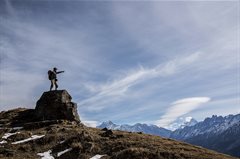Kuari Pass Trek
The most scenic winter trek for beginners
Available Batches
Available Batches



Brief Description
Brief Itinerary
Detailed Itinerary
Day 1
Arrive in Joshimath (2040 M)
Arrive in Joshimath. If you opt for transportation from us then we will assemble early morning in Dehradun ISBT by 7 AM and drive towards Joshimath. Overnight in guest house / hotel in Joshimath
Day 2
Joshimath to Dhak (by car) and trek to Tali (3362 M)
Distance: 8 kms
Duration: 7 hours
After breakfast around 7:30 AM, we head to Dhak Village to start our trek. Keep a jacket handy, you may need it along the way, but if the sun is up, you can easily trek in a t-shirt and a fleece. You’ll walk through the dusty trails up to Tugashi village, which will be your first water source. It’s a charming little village, where you’ll get a glimpse of the traditional way of life of the locals. As you move further up from Tugashi village, the terrain changes and you’ll find yourself walking in and out a beautiful oak forest. The forest opens up to a clearing or a meadow every now and then. You’ll have your lunch at Gulling around 1 pm, rest up here but gear up for the final ascend to the Tali Campsite from here. It’s not a steep ascend, but for the next 4KMs, you’ll be walking uphill. Tali campsite is right in the middle of the forest, and you’ll be delighted to be there because you’ll have a team waiting with hot beverages and snacks for you.
Day 3
Tali to Kuari Pass (3814 M) to Tali
Distance: 12 kms
Duration: 7 hours
Today is going to be an epic day. It’s much easier than the previous day, as you will go up and down hills and snow slopes (in the winter months). The trek today will amaze you with the glorious views of the mountains around you, the snowfield you’ll traverse through and the feeling of being on top of the world at Kuari Top. It would take you around 4 hours to reach Kuari Top, which is the highest point on the trail, from there, Kuari Pass is just 700 meters (40 minutes) away. Today you’ll see peaks like Neelkantha, Nanda Devi, Hathi Ghoda Parvat, Dronagiri, Pangarchulla, and Chaukhamba. After spending some time at the pass, we retrace the same route to reach Tali by late afternoon.
Day 4
Tali to Auli (3048 M) via Gorson bugyal. Drive to Joshimath.
Distance: 10 kms
Duration: 7 hours
If the views blew your minds away yesterday, today is going to be an even better day. 800 meters of steady climb after the camp, you’ll be out of the forest. Your first break point would be at the beautiful Tali lake. You’ll be able to get clear views of Nanda Devi from Tali lake, which is the highest mountain in India. The trail from here climbs onto a narrow path, with the mountain on one side and a steep drop on the other. Make sure you walk as a team on this path, as people scared of heights or prone to vertigo, might feel a little uncomfortable here. This narrow path continues for 1.5 KMs till you enter Gorson Bugyal. For the next 5KMs you’ll walk in a beautiful wide open meadow, and in the winter months, the snow makes the landscape absolutely stunning. You’ll find a lot of day hikers here from Auli, who come here to experience the snow. Reach Auli Ski Resort and board the vehicle for Joshimath from Auli road head. The drive from Auli to Joshimath is around an hour. Your trip ends here, and now it’s time to take a hot shower, relax and celebrate.
Day 5
Depart from Joshimath (2040 M)
The trip ends today. Checkout of the guest house. If you opt for transportation from us then we will reach Dehradun by late evening.
What's Included
- Food as per menu on the trek (Starting Lunch on Day 2)
- Forest Permits/Camping Charges , if any
- Tents, Sleeping bags, mats,Technical equipment
- Safety Equipments.
- Trek guide, cook, helpers, porters & mules for carrying common luggage.
- Services of a Trek Leader.
- 2 Nights Hotel stay in Joshimath.
What's Not Included
- Meals during road journeys
- Meals during hotel stay
- Any expense of personal nature
- Any expense not specified in the inclusion list
- Transportation from Dehradun to Joshimath and back to Dehradun.
- Medical Checkup Fee of INR 300 at Joshimath Govt. Hospital.
Are you Eligible for this Adventure?
BRS Level Required
Since it is a beginner’s trek, you need no special prior experience. Although any high-altitude trek requires a certain level of stamina and physical endurance.
If you do not know what level of BRS trek would suit you best, worry not! Fill out this Form:
we will send you a progression chart to help you comfortably get out of your comfort zone in order to level up and ultimately reach your highest potential in the big, bad world of outdoor adventure.
Packing List
This is a list of essential items for individuals doing the trek with Bikat Adventures. This list contains only those items which the participants are required to bring with them. The list excludes those items which are provided by Bikat Adventures on the trek. We have divided the items into five categories. All the items in the list are essential except for those marked as optional.
Trekking Gear
- Ruck sack bag with rain cover. Qty -1
- Day Pack Bag - Recommended for treks with summit day
- Head Torch with spare Batteries. Qty -1
- U V protection sunglasses. Qty -1 Here is how you can choose the best sunglasses for trekking.
- Water Bottles: 2 bottles of 1 liter each
Footwear
- Non-skid, deep treaded, high-ankle trekking shoes Qty -1
- Pair of light weight Slipper/Sandals Qty -1
Clothing
- Quick Dry Warm lower or Track Pants. Qty - 2
- Full sleeves T-shirts/ Sweatshirts. 1 for every 2 days of trekking
- Pair of thick woolen socks. 1 pair for every two days of trekking
- Thermal Body warmer Upper & Lower. Qty-1
- Undergarments. Qty - 1 for every day of trekking
- Warm jacket closed at wrist & neck .Qty-1
- Full sleeves sweater. Qty -1
- Rain wear ( Jacket & Pants ) . Qty-1
- Pair of waterproof, warm gloves. Qty-1
- Woolen cap. Qty-1
- Sun shielding Hat. Qty -1
Toiletries
- Personal toiletries kit (Small Towel, Toilet paper, paper soap, Bar soap, toothbrush, toothpaste, cold cream, etc.)
- Sun screen lotion small pack. Qty -1 Here is your Sun Protection 101 to stay safe in the bright sunny outdoors.
- Lip Balm small pack. Qty-1
Utensils
- Small size, Light weight & Leak proof lunch box. Qty-1
- Plate. Qty- 1
- Spoon.Qty-1
- Tea/Coffee (plastic) Mug.Qty-1
Miscellaneous
- Camera (Optional)
- Carry your medicines in plenty in case you have any specific ailment. Consult your doctor before joining the trek.
- Dry fruits, Nuts, Chocolate bars (Optional)
Frequently Asked Questions
Why Bikat?


Small Group Size
Our batch sizes are capped at 15 for smaller treks with the trek leader and trekker ratio of 1:8. This ratio, in our years of experience, has proven to deliver the best trekking experience for individuals as well as groups. Capping the size of the group ensures individual attention to each trekker so that no signs of distress or need during the trek go unnoticed. It also helps to form a more cohesive cohort with better group energy which helps define the rhythm and pace of days on the trek. As you go higher up on the BRS scale, since the stakes are higher, expeditions have an even smaller group size with the ratio of expedition leader to climber set at 1:2.


Qualified Trek Leaders
We follow a rigorous regime of hiring and training our experts in the field. Each trek leader is a certified mountaineer with years of experience in the field. In addition to their qualification, they also go through practical and situational training to tackle any and all kinds of sudden conditions that may present themselves on the ground. Being unpredictable is the core nature of the mountains but being ready for any circumstance as best as possible is a controllable asset that we try to nurture. Our field experts are also trained in basic medicine and first-aid response. Watch: Forerunners - The Making of A Trek Leader At Bikat Adventures


Guided Progression
Since Bikat Adventures is a learning-based organization, we help you climb up the ladder of difficulty within the sphere of outdoor adventure systematically. Our on-ground training modules are designed to handhold you through the upskilling process so that you are ready to take on bigger challenges.


Equipment Quality and Check
All the gear used on our treks and expeditions is tried and tested, maintained for good quality, and is overall top-notch in quality and condition. We are continually looking to obtain the best of everything there is in the market so as to ensure optimum safety.


Support Systems
Along with the staff you see on-ground, we have a team of superheroes working in the background to give you the best experience possible. Our background team also comprises local staff from each area who know the region best. Having local support helps with studying the area, pre-planning, execution, and in receiving timely support in case of emergencies in these remote locations.


Communication
Our on-field staff is in constant contact with our teams based in primary locations so as to eliminate any avoidable delay in reaching additional help and support when required. We try to use the best tools for communication available, including satellite phones, in regions where they are not restricted.
What our customers Say
Cancellation Policy
Cash refund
Cancellations up to 60 days prior to departure date
Between 60 days upto 30 days prior to departure date
Between 30 days upto 10 days prior to departure date
Less than 10 days prior to departure date
Voucher refund
Cancellations up to 30 days prior to departure date
Between 30 days upto 15 days prior to departure date
Between 15 days upto 10 days prior to departure date
Less 10 days prior to departure date
- Cash refund is applicable only in case of bookings made without using any promotional offer code or Cancellation Vouchers or Discounts
- This is only a brief of cancellation terms. For finer details please refer Detailed Cancellation Policy.
Blog Posts







Similar Adventures

Brahmatal Trek
The Best Beginners' Trek in Uttarakhand
Uttarakhand
6 Days
BRS 3
3856 m

Har ki Dun Trek
A Gorgeous River Valley Trek for Beginners
Uttarakhand
7 Days
BRS 3
3500 m

Panwali Kantha Trek
Uttarakhand
5 Days
BRS 3
3500 m





































